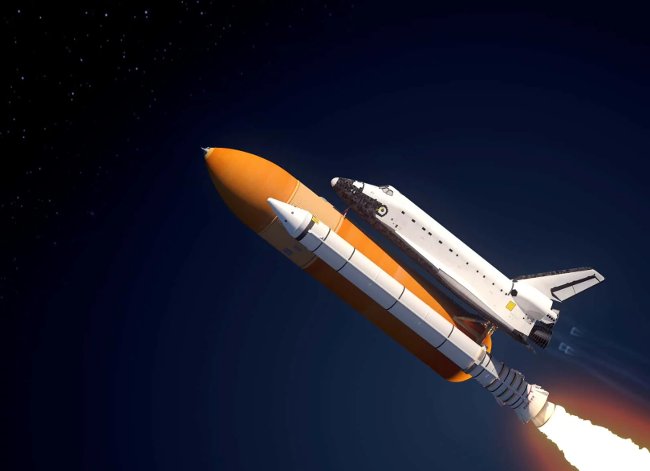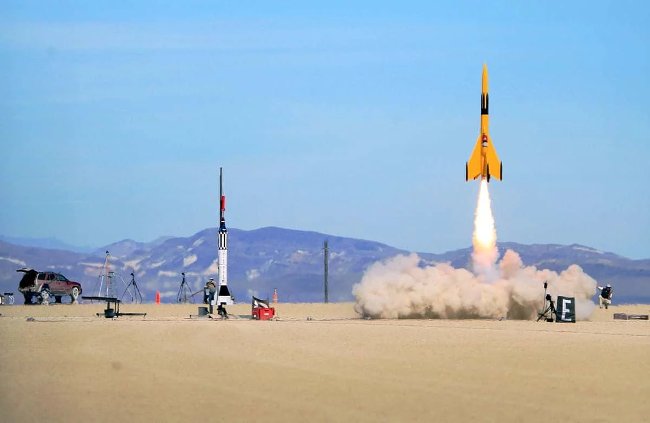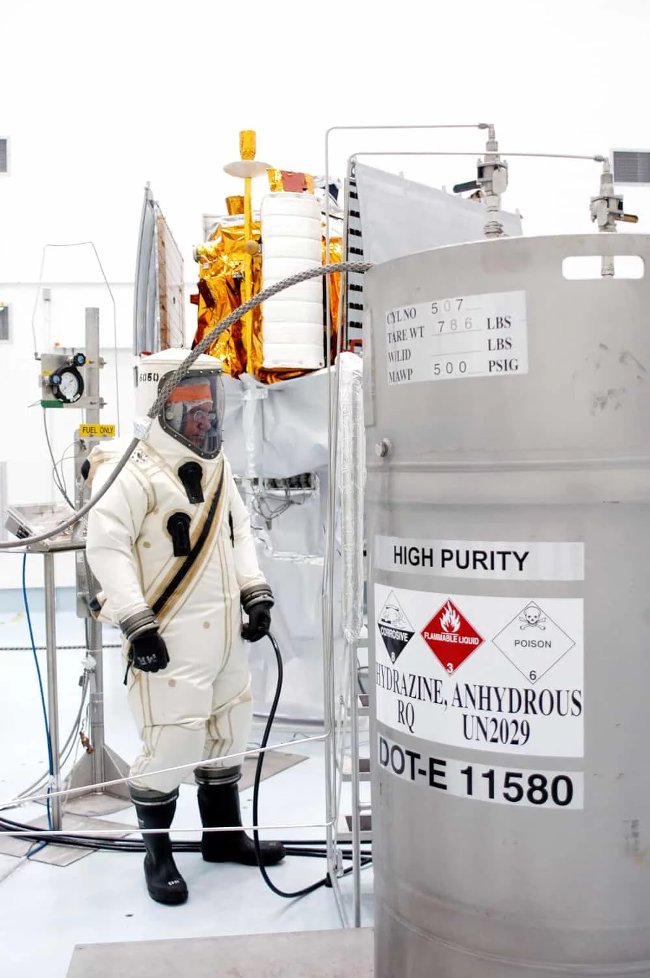How does rocket work in space?
Commercial airplanes and fighter planes burn fuel by using the oxygen available in the atmosphere, but what about those missiles flying into space? In fact, there is no air in aerospace, so how can rockets ignite essential engines and fuels needed in space?
Short answer : Only two components are needed for the combustion reaction, which is fuel and oxidation . Most cosmic rockets carry their fuel and oxidants into space, so they don't need to rely on the oxygen available in that space. Furthermore, it is not necessary to fire to provide rocket propulsion; You can gain thrust by simply pushing " mass " out of the rocket.
 Rocket in space.Photo source: 3dsculptor / Fotolia).
Rocket in space.Photo source: 3dsculptor / Fotolia).
How can rockets work in space?
Almost in space there is no air, so how can rockets work there? Because they have no air to repel, so how to accelerate or change the direction?
Certainly one of us has also learned about Newton's Law of Motion in high school. All forms of movement in this world are thought to be dominated by three major laws of Newton's motion, missiles are no exception.
Observe the most basic form of motion - walking . To be able to walk, we have to set our feet firmly on the ground and then push back to the ground, then move forward.
 When walking on the ground, the repulsive force helps us step forward.That's the basic thing we can do when walking.(Image source: Pixabay).
When walking on the ground, the repulsive force helps us step forward.That's the basic thing we can do when walking.(Image source: Pixabay).
Of course, this seems silly to think that we, with weak legs, can " push " the ground, but that's exactly what happens. Because the Earth's mass is significantly larger than the body weight, the ground does not really push back. The type of action reaction is governed by Newton's Law III , which states that " for every action, there is always a reaction of the same magnitude and vice versa ".
You can follow the law of motion III in countless cases. Suppose there are two small boats in the middle of the lake. If a person jumps from one boat to another, the first boat will be pushed backwards as soon as the person jumps.
 Example of Newton's law of motion.
Example of Newton's law of motion.
It is this law that helps rockets move and transform in space.Rocket engine is a jet engine. To move forward, a rocket launches high-pressure gas ( produced by the combustion reaction ) from its tail. Therefore, the action ( air spray ) activates the reaction ( ie the missile moves forward ).
However, as mentioned above, gas emitted from combustion and combustion reactions, a traditional combustion reaction, requires oxygen to burn. After all, we all know that there is no air in the air.
So . what is the alternative here?
How can missiles work in space without oxygen?
Fire cannot burn without two important elements: fuel ( flammable ) and oxidizing agent ( start the combustion process and maintain it ). So you need fire to propel the rocket, but there is not enough air ( oxidizing agent ) in space. So what can be done?
In fact, this is really simple: if you go to the drawing competition, but that place doesn't give you the color paints, what will you do? Do you bring your own paint? Very simple!
That's exactly what most space spacecraft do. Many rockets carry a liquid oxygen tank, which acts as the oxidizing agent needed to maintain the combustion reaction. The most commonly used fuels in such types of rockets are liquid hydrogen or kerosene.
 Fuel and oxidants combine inside the rocket to start the burning reaction.
Fuel and oxidants combine inside the rocket to start the burning reaction.
In fact, thousands of oxidation-fuel combinations have been used in aerospace missiles over the years, but liquid hydrogen and liquid oxygen are still one of the most effective mixes.
Solid rocket fuel
Note that you do not need to use oxygen as an oxidizing agent. Almost all solid-fuel rocket engines use aluminum powder as fuel and ammonium perchlorate, composite propellant fuel ( solid rocket propellant used in manned and unmanned rocket vehicles. ) as an oxidizer.
 A rocket was launched using solid fuel.(Image source: Steve Jurvetson / Wikimedia Commons).
A rocket was launched using solid fuel.(Image source: Steve Jurvetson / Wikimedia Commons).
Hyperbolic push explosives
As mentioned above, you do not need oxygen to create fire inside a rocket, because there are certain chemicals - when in contact with each other - naturally burns.Propellants that use these chemicals are called hyperbolic propellants .
The most common hyperbolic fuels include hydrazine, monomethylhydrazine and unsymmetrical dimethylhydrazine, often used together with nitrogen tetrachloride ( oxidizing agent ) to activate self-igniting, meaning you do not need oxygen to produce fire.
 The supply of fuel ( containing hydrazine as fuel ) is loaded into the space ship MESSENGER.(Image source: NASA / Wikimedia Commons).
The supply of fuel ( containing hydrazine as fuel ) is loaded into the space ship MESSENGER.(Image source: NASA / Wikimedia Commons).
Monopropellant (Single component fuel)
 Monopropellant - one-component fuel commonly used in reactive controllers, provides height adjustment.
Monopropellant - one-component fuel commonly used in reactive controllers, provides height adjustment.
These propellants include chemicals that release energy and release mass after chemical decomposition. This fuel often contains substances such as hydrazine or concentrated hydrogen peroxide exposed to iridium catalysts.Monopropellant - one-component fuel commonly used in reactive controllers, provides height adjustment.
All of the above mentioned is to say that, while oxygen is undoubtedly an essential oxidant on Earth to produce fire, on the contrary, you don't necessarily need to use oxygen to propel the rockets in space. By having a few other alternatives!
- The greatest landmarks in SpaceX history
- Video: Use a jet to support the rocket launch process
- The US military declares a European rocket explosion in space
- Humans will
- NASA announces how to make space rockets
- Video: Explain rocket science with 1,000 common English words
- Virus steals information about Japanese space rocket
- Video: Rocket launcher looks from the universe
- Follow the rocket to outer space and return to Earth
- Japanese space agency launched the world's smallest satellite rocket
- Russia leads the number of launches to space
- Russia launched TMA 8 into space
 Van Allen's belt and evidence that the Apollo 11 mission to the Moon was myth
Van Allen's belt and evidence that the Apollo 11 mission to the Moon was myth The levels of civilization in the universe (Kardashev scale)
The levels of civilization in the universe (Kardashev scale) Today Mars, the sun and the Earth are aligned
Today Mars, the sun and the Earth are aligned The Amazon owner announced a secret plan to build a space base for thousands of people
The Amazon owner announced a secret plan to build a space base for thousands of people